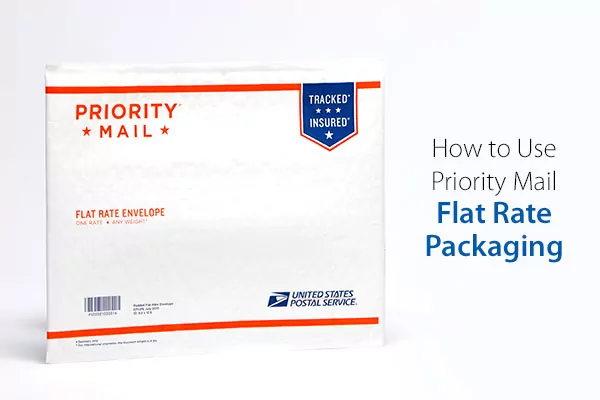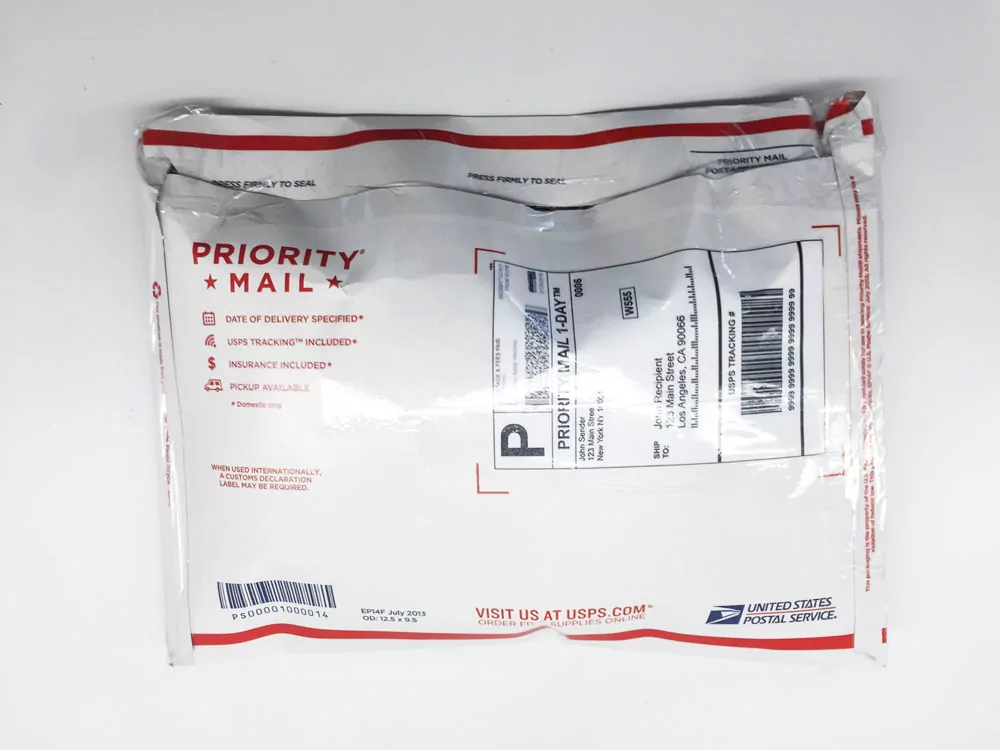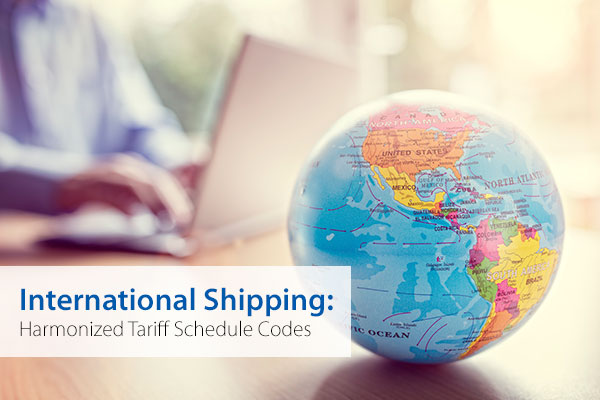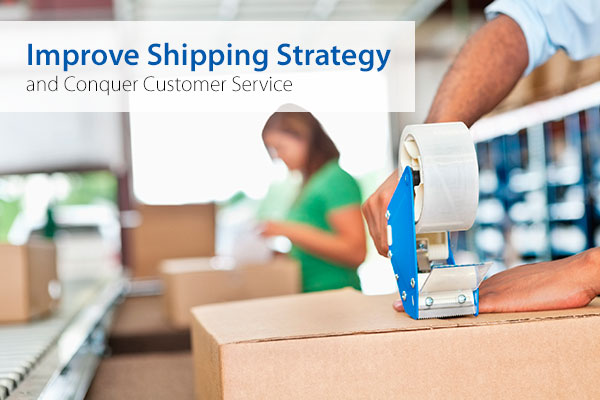
Priority Mail Flat Rate Envelopes feature one low flat rate, so price is determined by the box or envelope you choose and not by the weight or distance the package is traveling. Flat Rate Envelopes can help save you a lot of money.
Not sure if your package will pass as a Priority Mail Flat Rate® Envelope? Here are a few guidelines to help you decide:
1. If it fits, it ships.If you are able to easily close the prefabricated folds of your Flat Rate Envelope, you should be good. However, if using tape or an insert is the only way to get your Flat Rate Envelope to close, then you will be required to use a different mail class.
2. Use tape to reinforce, not close.You can use tape to reinforce the seams of the Flat Rate Envelope, but the amount of tape being used should not encase the envelope!
3. Flat refers to price, not shape.With Flat Rate Envelopes, bulges and thickness may not matter. Flat Rate Envelopes are best suited for documents, but if you choose to send another type of item (up to 70 pounds), it should not reconstruct or expand the envelope in any way. As long as the envelope closes within the normal folds, bulges will not matter. There is no maximum thickness for Flat Rate Envelopes.
Still not sure what a reconstructed Flat Rate Envelope looks like? Take a look at the image below:

What happens if you use a reconstructed Flat Rate Envelope?
If you use a reconstructed envelope, know that the USPS may charge you according to weight and zone –in other words, Flat Rate pricing won’t apply. You may also have to repackage the item if it runs the risk of damage during transit.
Note: You can order Priority Mail Flat Rate Envelopes from the Stamps.com Store.
What happens if the USPS rep denies your Flat Rate Envelope?
If your package meets all the guidelines above, but a USPS rep still denies it, you may point them to the DMM regulation around Flat Rate Envelopes which can be found here: http://pe.usps.com/text/dmm100/flat-rate-reference.htm.
Mail and Ship Anything From Home, Office, or Your Phone.

You may have spotted a box called “HS Tariff” in the Stamps.com International Shipping Label’s Customs Information section. What is it and what is it used for?
The Harmonized System, or HS, Tariff code is used to classify physical goods and traded products for export to another country. In the Stamps.com software, you have the option of entering a six-digit HS Tariff, a value developed and maintained by the World Customs Organization (WCO).
Why would you need this code? The codes are used by countries’ customs services to assess product quotas and correctly levy tariffs. This is not necessarily a bad thing: your commodity may qualify for a preferential tariff under a Free Trade Agreement.
Getting Your HS Tariff Code
So where would you get an HS Tariff code? To locate a specific code, please visit: http://hts.usitc.gov/
The Harmonized Tariff Schedule allows you to classify a specific product or product type with a numbered code. It will also provide information on the Tariff Rate of Duty.
Are you an exporter of table-tennis equipment? In the Tariff Schedule search engine, type in “table-tennis.” Reviewing the results, you’ll see HS Tariff code 9506, which is for “articles and equipment for general physical exercise, gymnastics, athletics, other sports (including table-tennis).” What if you’re an exporter of extracts, essences and concentrates of coffee, tea, or roasted chicory? Then your HS Tariff code is “2101.”
The goal is to pick the most specific tariff code for your item. For example, knives with silver handles would have the Tariff Code of 7114.11.10. Tricycles, scooters, and pedal cars would be 9503.00.00. Perfumed bath salts would be 3307.30.
Using HS Tariff Codes in Stamps.com
To use an HS Tariff code, please select “Commercial Sample” as the Content Type in the Customs Form. You’ll notice some codes are longer than six characters, the maximum limit for the HS Tariff code in the Stamps.com software. Don’t worry: because the HS Tariff classification protocol is used by almost the entire international community, participating countries can add more digits to classify items with more specific detail. However, the first six digits are the same across all participating countries. Because of this, only the first six are used on Stamps.com Customs Forms.
The Customs Form will also ask for a “Country of Origin.” This refers to the origin of the product, not the origin of the mailpiece as a whole. This is required for the sake of security and to prevent any illicit or fraudulent activity, or anything that violates existing export laws.
Once you enter the Itemized Package Content Details, Value, Weight, Country of Origin, and add each line item by clicking on the “Add Item” button, you will be asked to acknowledge the USPS Privacy Act Statement and Restrictions and Prohibitions. Review that, and click OK.
Your form is now ready to print. The HS Tariff Number will appear in a box on the left of your International Shipping Label/Customs Form.

To run a successful business, you need to have great customer service. While brick-and-mortar stores capitalize on the face-to-face communication we often associate with customer service, online businesses can still master the art of communicating with their customers – namely, through their shipping process. Here are five ways to master customer service by improving your shipping strategy.
1. Be clear about shipping expectations
Negative feedback is overwhelmingly related to issues associated with shipping. To hedge your bets and negate this, provide very realistic expectations for when an item should arrive. Be transparent, and explain the difference between shipping (when an item leaves your possession or warehouse to begin its journey to the customer) and delivery (when the package arrives on the buyer’s doorstep). During high-volume times like the holidays, provide a shipping time table that lets buyers see how soon they need to order packages to expect them by Christmas. Always try to get items to the Post Office the day the order was placed or within 24 hours, if possible. If and when packages show up early, buyers will be pleasantly surprised and more likely to leave positive feedback.
2. Include a custom packing slip
Marketplaces like Amazon have strict rules on how you can contact and interact with a buyer. The packing slip is a safe way to connect, and can help personalize the buying experience. Write a brief note within the packing slips thanking buyers for their patronage, letting them know that they are welcome to contact you, if necessary, and leaving the best method of contacting you. This will reassure buyers that you care, and that you’re just a phone call or email away should they need to reach out. The best packing slips I’ve seen also include a handwritten thanks with the signature of the employee that packaged my item. A reported 68% of customers will stop supporting a business if they feel that the company is indifferent towards them. Bring some humanity to the shipping experience and let buyers know you care.
3. Offer a discount for their next purchase
Discounts and coupons encourage repeat salesand demonstrate that you appreciate a customer’s business. As always, you must abide by each marketplace’s rules when offering discounts or coupons. It is legal to extend a discounted offer, but you cannot do so in exchange for positive feedback. A coupon for their next purchase may encourage feedback organically, but you can’t use it an as incentive.
4. Brand your packaging
The more you can make your buyers’ shopping experience stand out, the better. A 10-year study found that brands that can evoke an emotional connection with buyers can effectively charge up to 200% more than competitors. Branding your packaging will contribute to this. If you sell on your own website, you have free rein to package as creatively as you like. That said, you can still offer a unique experience on stricter marketplaces. After you have the appropriate packing materials, like bubble mailers or sturdy boxes, what can you add to set yourself apart from competitors and create a fun experience for customers? What unique addition would make sense with your brand persona? I recently ordered balloons from a small, party supplies seller on Etsy. When the package arrived, I opened the bubble mailer and confetti came out. It was fun, surprising, and totally consistent with the brand. Creating a genuinely fun shipping experience for me set this seller apart from her competitors, and demonstrated to me that she thinks about her customers from start to finish. I loved it, and I will definitely purchase from her again.
5. Make all returns free
We know not every seller is able to make free shipping work with their budget. Free, unconditional returns is a great alternative to offering unlimited free shipping, and benefits the customer and retailer alike. Here’s why: a reported 49% of consumers believe shipping costs to be the most exasperating aspect of returning an item. Another 88% of consumers would rate free return shipping as either “important” or “very important” when making purchase decisions, and 82% of another test group affirm that they would complete an online purchase if the seller offers free return shipping. Making returns easy and free for the buyer is a great way to nail customer service and promote buyer trust. And if a buyer does make a return, they are more than likely going to shop from you again in the future, if your return shipping is free.
Offering exceptional customer service through your shipping process doesn’t just impress customers – it encourages future purchases, stewards repeat buyers and helps you win out over competitors. Get creative with branding, be generous with returns and communicate with buyers that you’re a reliable and considerate retailer. If you can nail this, you will reap the benefits. Happy selling!

Ecomdash is an award-winning multichannel inventory software for e-commerce retailers. It offers an end-to-end e-commerce solution to complete workflow, including inventory and sales order management, product listing, dropshipping and fulfillment management, reporting and more.